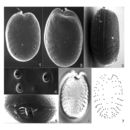Ecology
provided by NMNH Marine Dinoflagellates
P. mexicanum is a benthic species that can be tycoplanktonic (Steidinger & Tangen 1996). Cells swim freely or attach to floating detritus with mucous strands. Cells are often found embedded in mucilage (Faust 1990b).
- bibliographic citation
- Faust, Maria A. and Rose A. Gulledge. Identifying Harmful Marine Dinoflagellates. Smithsonian Contributions from the United States National Herbarium, volume 42: 1-144 (including 48 plates, 1 figure and 1 table).
Habitat and Locality
provided by NMNH Marine Dinoflagellates
P. mexicanum is a common species found in tropical and subtropical benthic communities (Steidinger & Tangen 1996) of shallow protected areas of the Pacific and Atlantic Oceans (Faust 1990b).
- bibliographic citation
- Faust, Maria A. and Rose A. Gulledge. Identifying Harmful Marine Dinoflagellates. Smithsonian Contributions from the United States National Herbarium, volume 42: 1-144 (including 48 plates, 1 figure and 1 table).
Morphology and Structure
provided by NMNH Marine Dinoflagellates
P. mexicanum is a photosynthetic species with a posterior nucleus (Faust 1990b).
- bibliographic citation
- Faust, Maria A. and Rose A. Gulledge. Identifying Harmful Marine Dinoflagellates. Smithsonian Contributions from the United States National Herbarium, volume 42: 1-144 (including 48 plates, 1 figure and 1 table).
Nomenclatural Types
provided by NMNH Marine Dinoflagellates
Holotype: Prorocentrum mexicanum Tafall, 1942: plate 34, figs. 3, 8
Type Locality: North Pacific Ocean: Mexico
- bibliographic citation
- Faust, Maria A. and Rose A. Gulledge. Identifying Harmful Marine Dinoflagellates. Smithsonian Contributions from the United States National Herbarium, volume 42: 1-144 (including 48 plates, 1 figure and 1 table).
Reproduction
provided by NMNH Marine Dinoflagellates
P. mexicanum reproduces asexually by binary fission. Sexual reproduction has also been observed in natural cell populations (Faust, M.A., pers. com.).
- bibliographic citation
- Faust, Maria A. and Rose A. Gulledge. Identifying Harmful Marine Dinoflagellates. Smithsonian Contributions from the United States National Herbarium, volume 42: 1-144 (including 48 plates, 1 figure and 1 table).
Species Comparison
provided by NMNH Marine Dinoflagellates
With its prominent periflagellar collar, P. mexicanum most resembles P. caribbaeum in general cell shape; however, P. caribbaeum is a larger species, is broader and heart-shaped, and broadest in the anterior region (Dodge 1975; Faust 1993a). Trichocyst pore morphology is also similar in these two species; however, significant differences lie in the number of trichocyst pores: P. caribbaeum has a greater number of pores per valve (145-203) than P. mexicanum (100 per valve). Ejected trichocysts are often observed in cells of both species (Faust 1990b; 1993a). P. mexicanum, P. emarginatum and P. caribbaeum all have radially arranged valve pores and display two different sized pores (Loeblich et al. 1979; Fukuyo 1981; Steidinger 1983; Faust 1990b; 1993a). The periflagellar area and platelet architecture of P. caribbaeum is similar to that of P. mexicanum (Carlson 1984; Faust 1993a). The intercalary band of P. mexicanum is transversely striated. This is similar to P. caribbaeum and P. emarginatum (Faust 1990b; 1993a).
- bibliographic citation
- Faust, Maria A. and Rose A. Gulledge. Identifying Harmful Marine Dinoflagellates. Smithsonian Contributions from the United States National Herbarium, volume 42: 1-144 (including 48 plates, 1 figure and 1 table).
Species Overview
provided by NMNH Marine Dinoflagellates
P. mexicanum is an armoured, marine, benthic dinoflagellate species. This toxic species is commonly found in tropical shallow embayments.
- bibliographic citation
- Faust, Maria A. and Rose A. Gulledge. Identifying Harmful Marine Dinoflagellates. Smithsonian Contributions from the United States National Herbarium, volume 42: 1-144 (including 48 plates, 1 figure and 1 table).
Synonyms
provided by NMNH Marine Dinoflagellates
Prorocentrum maximum Schiller, 1937
Prorocentrum rhathymum Loeblich, Sherley and Schmidt, 1979
- bibliographic citation
- Faust, Maria A. and Rose A. Gulledge. Identifying Harmful Marine Dinoflagellates. Smithsonian Contributions from the United States National Herbarium, volume 42: 1-144 (including 48 plates, 1 figure and 1 table).
Taxonomic Description
provided by NMNH Marine Dinoflagellates
P. mexicanum is a bivalvate species often observed in valve view. Cells are ovate to oblong with straight sides (30-38 µm long and 20-25 µm wide) (Figs. 1, 2, 6). The valve surface of young cells is smooth (Fig. 2), but in older cells it may appear rugose (Figs. 1, 3, 5). Both valves have many large trichocyst pores (100 per valve) radially arranged in furrowed depressions (Figs. 1-5), and 80 marginal pores (Fig. 3). Trichocyst pores are round with a smooth edge (0.5 µm in diameter) and even in size (Fig. 4). Ejected trichocysts are common. Valve's center is void of pores. The intercalary band is broad and transversely striated (Figs. 3, 5) (Faust 1990b). The periflagellar area, located apically and off-center on the right valve, is a relatively small, V-shaped, shallow depression (Figs. 1, 5). It houses a prominent curved periflagellar collar adjacent to the auxiliary pore (Figs. 1, 2, 5). Opposite is a smaller periflagellar plate adjacent to the flagellar pore (Fig. 5). The large periflagellar collar (2 X 6 µm) may appear as an apical spine, and has been reported as such (Fukuyo 1981; Carlson 1984). Both valves are excavated (Figs. 1 2) (Faust 1990b).
- bibliographic citation
- Faust, Maria A. and Rose A. Gulledge. Identifying Harmful Marine Dinoflagellates. Smithsonian Contributions from the United States National Herbarium, volume 42: 1-144 (including 48 plates, 1 figure and 1 table).
Toxicity
provided by NMNH Marine Dinoflagellates
P. mexicanum is a known toxin-producing species (Steidinger 1983; Carlson 1984; Tindall et al. 1984) producing fast-acting toxin (FAT) (Tindall et al. 1984).
- bibliographic citation
- Faust, Maria A. and Rose A. Gulledge. Identifying Harmful Marine Dinoflagellates. Smithsonian Contributions from the United States National Herbarium, volume 42: 1-144 (including 48 plates, 1 figure and 1 table).

